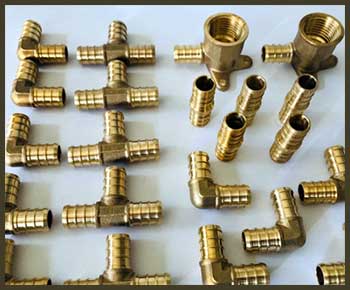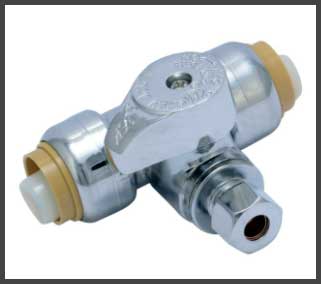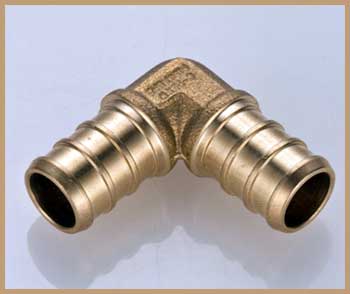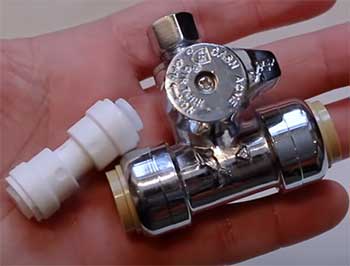I’ve spent countless hours wrenching pipes, sweating over connections, and cursing leaks in my home’s plumbing. When it comes to push-to-connect fittings, Efield and SharkBite are two names that keep popping up.
In this article, I’ll share my firsthand experience comparing these brands, breaking down their pros and cons, and helping you decide which is better for your plumbing needs.
With a conversational yet analytical approach, I’ll explore key features, durability, and practical applications to guide you through choosing the right fitting for your next project.
A Brief Comparison Table
| Feature | Efield | SharkBite |
| Material | Lead-free brass, stainless steel teeth | Lead-free brass, stainless steel teeth |
| Pipe Compatibility | Copper, PEX, CPVC, PE-RT | Copper, PEX, CPVC, PE-RT, HDPE |
| Ease of Installation | Simple push-to-connect, no tools needed | Simple push-to-connect, no tools needed |
| Durability | High, with corrosion-resistant brass | High, but O-ring concerns for long-term use |
| Warranty | Limited lifetime warranty | 25-year warranty (with proper installation) |
| Price | Generally more affordable | Premium pricing, higher cost |
| Applications | Indoor, some outdoor (with protection) | Indoor, underground, behind walls (with wrapping) |
| Availability | Limited retail, mostly online | Widely available in major retailers |
| Max Pressure/Temp | 200 PSI, 200°F | 200 PSI, 200°F |
My Journey With Push-to-Connect Fittings
As a DIY enthusiast who’s tackled everything from leaky faucets to full bathroom remodels, I’ve learned that plumbing is equal parts art and science. A few years back, I was staring at a copper pipe in my basement, dreading the idea of soldering it in a tight space.
That’s when I discovered push-to-connect fittings. They promised quick, tool-free connections that even a novice like me could handle. Efield and SharkBite quickly became my go-to brands, but I soon realized they’re not created equal.
Let’s break down what makes each tick, starting with their core features.
Key Features of Efield Fittings

Efield fittings caught my eye because they’re budget-friendly without skimping on quality.
Made from lead-free brass with stainless steel grip teeth, they’re designed to hold tight on copper, PEX, CPVC, and PE-RT pipes.
The push-to-connect mechanism is a dream—you just clean the pipe, push it in, and you’re done.
No soldering, no crimping, no fuss. I used Efield fittings for a quick sink repair under my kitchen counter, and the process took less than five minutes.
Their fittings are rated for 200 PSI and 200°F, which covers most household plumbing needs.
What I love about Efield is the simplicity. The O-ring inside creates a watertight seal, and the stainless steel teeth ensure the pipe doesn’t budge. They’re also corrosion-resistant, which is a big deal in my humid basement.
Efield offers a limited lifetime warranty, which gave me confidence when I installed them in less accessible spots. However, they’re not as widely available as I’d like—mostly found online or in select hardware stores. This can be a hassle if you need a fitting in a pinch.
Pros of Efield Fittings
Let’s talk about why Efield became my dark horse favorite. First, the price is a major win. When I was re-piping my laundry room, Efield fittings cost about 20-30% less than SharkBite for similar components. For a budget-conscious DIYer, that adds up fast.
The quality doesn’t feel cheap either—the brass feels solid, and the connections have held up for years without a drip.
Another pro is their reliability for indoor use. I’ve used Efield for everything from connecting PEX to copper for a new shower line to fixing a leaky toilet supply. Each time, the installation was straightforward, and the fittings have performed flawlessly.
The limited lifetime warranty is reassuring, especially since I’m not a pro plumber who can afford to redo a job. Plus, Efield’s fittings are compact, making them easier to fit in tight spaces compared to SharkBite’s bulkier designs.
Cons of Efield Fittings
But Efield isn’t perfect. Availability is a big drawback. When I needed an extra coupling for a weekend project, I couldn’t just run to my local hardware store—they don’t stock Efield as consistently as SharkBite.
Ordering online meant waiting a few days, which wasn’t ideal when water was pooling under my sink.
Another issue is their limited outdoor suitability. Efield fittings aren’t explicitly approved for underground or exposed outdoor use, so I had to be careful about where I installed them. The lack of clear guidance on long-term durability also gave me pause.
While I haven’t had issues, I wonder how they’ll hold up after a decade in my humid climate.
Key Features of SharkBite Fittings

SharkBite, on the other hand, is the rockstar of push-to-connect fittings.
Introduced in 2004, they’ve built a reputation for reliability and versatility.
Like Efield, they use lead-free brass and stainless steel teeth, but they’re compatible with a broader range of pipes, including HDPE.
This makes them a favorite for diverse projects, from water heaters to underground lines.
I used SharkBite to cap a pipe during an emergency leak, and the ease of installation was a lifesaver—no torch, no panic.
SharkBite’s fittings also handle 200 PSI and 200°F, and they’re approved for behind-the-wall and underground use (with proper wrapping). Their 25-year warranty is a strong selling point, though it’s contingent on correct installation.
The downside?
They’re pricier than Efield, and I’ve heard grumbles about the rubber O-ring degrading over time, especially in harsh conditions. Still, their availability at places like Home Depot and Lowe’s makes them a convenient choice for last-minute fixes.
Pros of SharkBite Fittings
SharkBite’s biggest strength is its versatility. Whether I’m working with copper, PEX, or even HDPE, SharkBite has a fitting for it. I used their fittings to install a new water heater, and the ability to mix and match pipe types saved me a ton of hassle.
Their approval for behind-the-wall and underground applications (with wrapping) also makes them a go-to for bigger projects. I felt confident burying a SharkBite connection in my yard, knowing it was code-compliant.
The ease of use is another major plus. During a late-night pipe burst, I grabbed a SharkBite cap, cut the pipe, and stopped the leak in under a minute. Their disconnect tool makes removal a breeze, too, which is great for temporary fixes or reconfigurations.
And let’s not forget availability—SharkBite is everywhere, from big-box stores to local plumbing shops. That accessibility has saved me more than once.
Cons of SharkBite Fittings
The biggest downside to SharkBite is the cost. When I was pricing out a full bathroom remodel, SharkBite fittings added up quickly—sometimes double the price of Efield for similar pieces. For large projects, that premium can sting.
Another concern is the O-ring. While I haven’t had failures myself, I’ve read stories of O-rings cracking or drying out, especially in outdoor settings exposed to sunlight. This makes me hesitant to use them in permanent, hidden installations without regular checks.
There’s also the issue of bulk. SharkBite fittings are noticeably chunkier than Efield’s, which can be a problem in tight spaces like under a sink. And while their warranty is solid, it’s only valid if you follow their exact installation guidelines.
Miss a step, and you’re on your own.
My Experiences With Efield And SharkBite

To give you a clearer picture, let me share a couple of projects where I used both brands.
First was a kitchen sink replacement.
I needed to connect a new PEX line to an existing copper pipe.
I chose Efield for its lower cost and compact design.
The installation was smooth, and three years later, there’s no sign of leaks.
The only hiccup was ordering the fittings online, which delayed the project by a day.
For a water heater install, I went with SharkBite because I needed fittings that could handle high temperatures and mixed pipe types (copper and CPVC). The process was just as easy, and the fittings felt robust.
But the cost was a shock—nearly $50 more than if I’d used Efield. Still, the peace of mind from their warranty and widespread approval for such applications made it worth it.
In both cases, the fittings performed well, but the choice came down to cost, availability, and project specifics. For quick, indoor fixes on a budget, Efield was my pick. For complex or high-stakes jobs, SharkBite’s versatility and certifications won out.
Key Differences Between Efield And SharkBite
- Durability and Longevity: What to Expect
Durability is where things get tricky. Both Efield and SharkBite use lead-free brass, which resists corrosion well. In my experience, Efield fittings have held up in indoor settings with no issues.
I’ve got a few in my basement that are going strong after four years, even with high humidity. However, I’m cautious about using them in hidden or outdoor spots since they lack explicit approval for those uses.
SharkBite’s track record is more established. I’ve seen installations in my friend’s home that are over a decade old and still leak-free. Their chloramine-resistant EPDM O-rings are a step above standard rubber, but I’ve heard concerns about them degrading in extreme conditions, like direct sunlight or high-cycle environments.
For behind-the-wall or underground use, SharkBite’s 25-year warranty offers reassurance, but only if you install them perfectly.
- Cost Considerations: Budget vs. Premium
Let’s talk money. Efield is the clear winner for budget-conscious folks like me. A typical ½-inch coupling might cost $5-$7 with Efield, compared to $10-$12 for SharkBite.
For a small repair, that’s no big deal, but for a whole-house repipe, the savings with Efield can be significant. I saved about $100 using Efield for my laundry room project, which I put toward better fixtures.
SharkBite’s higher price comes with benefits, though. Their wider availability means you’re not stuck waiting for shipping, and their certifications for underground and concealed use add value for professional or permanent installations.
If you’re a pro charging clients, SharkBite’s reputation might justify the cost. For DIYers like me, it’s a tougher sell unless the project demands their specific features.
- Installation: How Easy Is It Really?
Both brands make installation a breeze, but there are nuances. Efield’s fittings require a clean, deburred pipe end to avoid damaging the O-ring. I learned this the hard way when a jagged PEX pipe caused a minor leak.
Once I used a deburring tool, the connection was solid. The compact design also made it easier to maneuver in cramped spots, like behind my dishwasher.
SharkBite’s installation is just as simple, but their fittings are bulkier, which can be a pain in tight spaces. Their disconnect tool is a lifesaver, though—I’ve reused SharkBite fittings multiple times without issues.
Both brands require no special skills, but SharkBite’s broader pipe compatibility gives it an edge for mixed-material projects.
- Applications: Where Each Shines
Efield is my go-to for indoor, accessible repairs. I’ve used them for sink shut-off valves, toilet supply lines, and even a quick fix for a leaky showerhead.
They’re reliable for low- to medium-stakes jobs where cost and simplicity matter. However, I’d hesitate to use them for underground or behind-the-wall installations due to limited certifications.
SharkBite excels in versatility. I’ve used them for everything from emergency caps to connecting a new water heater. Their approval for concealed and underground use makes them ideal for professionals or homeowners tackling major projects.
I buried a SharkBite fitting in my yard for a sprinkler line, and it’s held up for two years with no issues, thanks to proper wrapping.
Plumbers’ Perspectives: Why The Skepticism?

I’ve talked to a few plumbers about these fittings, and their opinions are mixed.
Many prefer traditional soldering for its proven longevity, especially in permanent installations.
They argue that push-to-connect fittings, while convenient, introduce potential failure points with O-rings.
One plumber told me he trusts SharkBite for temporary fixes but wouldn’t use them in a client’s walls unless specified.
Efield gets less attention, likely due to its lower brand recognition, but the same concerns about long-term reliability apply.
The skepticism often comes down to trust. Soldered joints have a decades-long track record, while push-to-connect fittings are relatively new. For pros charging premium rates, the time saved with push-to-connect might not justify the perceived risk.
As a DIYer, I see the appeal of both sides—convenience versus proven durability.
Addressing Concerns: Lawsuits and Failures
There’s been chatter about SharkBite’s reliability, including a lawsuit that caught my attention. From what I’ve gathered, the lawsuit focused on early versions of SharkBite fittings, where some users reported leaks due to O-ring failures or improper installation.
I haven’t experienced this myself, but it’s a reminder to follow installation guidelines to the letter. Efield doesn’t have the same public scrutiny, possibly because it’s a smaller brand, but that doesn’t mean it’s immune to similar issues.
Failures, when they happen, are often tied to user error. I’ve seen leaks from poorly deburred pipes or fittings exposed to harsh conditions like UV light. Both brands emphasize proper prep—clean cuts, no burrs, and checking the pipe’s condition.
Ignoring these steps is a recipe for trouble, regardless of the brand.
Alternatives To Consider
If push-to-connect isn’t your thing, there are other options. Soldering copper pipes remains the gold standard for durability, though it requires skill and tools. I’ve sweated joints before, and while satisfying, it’s time-consuming and risky in tight spaces.
ProPress fittings are another alternative—brass fittings crimped with a specialized tool. They’re pricier than Efield but more trusted than SharkBite for permanent installations. Compression fittings are also an option, though they’re less forgiving if over-tightened.
For DIYers, I’d stick with push-to-connect for accessible repairs and leave soldering or ProPress to pros for hidden or high-pressure systems. It all depends on your skill level and project scope.
Frequently Asked Questions (FAQ)
Some plumbers avoid SharkBite due to concerns about O-ring degradation over time, preferring soldered joints for proven longevity in permanent installations.
The lawsuit involved early SharkBite fittings, with claims of leaks due to O-ring failures or improper installation, though specific details are sparse.
Yes, but failures are rare and usually tied to improper installation, like using damaged pipes or exposing fittings to sunlight, which can degrade O-rings.
Alternatives include soldered copper joints, ProPress fittings, or compression fittings, depending on the project’s permanence and your skill level.
Conclusion: Making The Right Choice For You
You’re standing in the hardware store aisle, staring at Efield and SharkBite fittings, wondering which to grab. I’ve been there, and it comes down to your project’s needs.
If you’re a DIYer like me, looking for a budget-friendly, reliable fix for indoor plumbing, Efield’s affordability and simplicity make it a solid choice. If you need versatility, certifications for concealed or underground use, or just the convenience of grabbing fittings off the shelf, SharkBite’s your pick—despite the higher cost.
Weigh your budget, project scope, and long-term goals, and you’ll find the right fit for your plumbing adventure.
